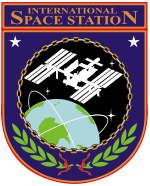ISS-Expedition 24
| Missionsemblem | |||
|---|---|---|---|
 | |||
| Missionsdaten | |||
| Mission | ISS-Expedition 24 | ||
| Besatzung | 6 | ||
| Rettungsschiffe | Sojus TMA-18, Sojus TMA-19 | ||
| Raumstation | Internationale Raumstation | ||
| Beginn | 2. Juni 2010, 0:04 UTC | ||
| Begonnen durch | Abkopplung von Sojus TMA-17 | ||
| Ende | 25. September 2010, 2:02 UTC[1] | ||
| Beendet durch | Abkopplung von Sojus TMA-18 | ||
| Dauer | 115d 1h 58min | ||
| Mannschaftsfoto | |||
 v. l. n. r. vorn sitzend: Alexander Skworzow (Kommandant) und Shannon Walker hinten stehend: Doug Wheelock, Tracy Caldwell-Dyson, Michail Kornijenko und Fjodor Jurtschichin | |||
| ◄ Vorher / nachher ► | |||
| |||
ISS-Expedition 24 ist die Missionsbezeichnung für die 24. Langzeitbesatzung der Internationalen Raumstation (ISS). Die Mission begann am 2. Juni 2010 mit dem Abkoppeln des Raumschiffs Sojus TMA-17 von der ISS. Ursprünglich sollte das Ende am 24. September 2010 durch das Abkoppeln von Sojus TMA-18 markiert werden.[2] Aufgrund eines technischen Defekts am Kopplungsmechanismus konnten jedoch Alexander Skworzow, Tracy Caldwell-Dyson und Michail Kornijenko am 24. September 2010 nicht abdocken und mussten wieder in die ISS zurückkehren. Der zweite Abkopplungsversuch einen Tag später am 25. September 2010 verlief ohne Probleme. Sojus TMA-18 landete gegen 5:23 Uhr UTC in der kasachischen Steppe nahe Arkalyk.
Mannschaft
Flugbesatzung
- Alexander Alexandrowitsch Skworzow (1. Raumflug), Kommandant (Russland/Roskosmos) (Sojus TMA-18)
- Michail Borissowitsch Kornijenko (1. Raumflug), Bordingenieur (Russland/Roskosmos) (Sojus TMA-18)
- Tracy Ellen Caldwell-Dyson (2. Raumflug), Bordingenieurin (USA/NASA) (Sojus TMA-18)
ab 17. Juni 2010:
- Fjodor Nikolajewitsch Jurtschichin (3. Raumflug), Bordingenieur (Russland/Roskosmos) (Sojus TMA-19)
- Shannon Walker (1. Raumflug), Bordingenieurin (USA/NASA) (Sojus TMA-19)
- Douglas Harry Wheelock (2. Raumflug), Bordingenieur (USA/NASA) (Sojus TMA-19)
Ersatzmannschaft
Seit Expedition 20 wird wegen des permanenten Trainings für die Besatzungen keine offizielle Ersatzmannschaft mehr bekanntgegeben. Inoffiziell gelten die Backup-Crews der beiden Sojus-Zubringerraumschiffe TMA-18 und TMA-19 (siehe dort) als Ersatzmannschaft der Expedition 24. In der Regel kommen diese Crews dann jeweils zwei Missionen später selbst zum Einsatz.
Siehe auch
- Liste der Weltraumausstiege
- Liste der Raumfahrer
- Liste unbemannter Missionen zur Internationalen Raumstation
Weblinks
- ISS-Expedition 24 auf den Seiten der NASA (engl.)
- ISS-Expedition 24 bei Spacefacts.de
- ISS-Expedition 24 bei Raumfahrer.net
Quellen
- ↑ Spaceflight Now: Space Station Report – Mission Status Center, abgerufen am 25. September 2010 (englisch)
- ↑ NASA: International Space Station Daily Report, abgerufen am 2. Juni 2010 (englisch)
Expedition 24 crew members take a break from training at NASA's Johnson Space Center to pose for a crew portrait. Pictured clockwise are Russian cosmonaut Alexander Skvortsov (bottom), commander; NASA astronauts Tracy Caldwell Dyson and Doug Wheelock; Russian cosmonauts Mikhail Kornienko and Fyodor Yurchikhin; along with NASA astronaut Shannon Walker, all flight engineers.
The official crew patch for Expedition 24, the 24th long-duration mission to the International Space Station.
- Science and Exploration are the cornerstones of NASA's mission onboard the International Space Station (ISS). This emblem signifies the dawn of a new era in our program's history. With each new expedition, as we approach assembly complete, our focus shifts toward the research nature of this world-class facility. Prominently placed in the foreground, the ISS silhouette leads the horizon. Each ray of the sun represents the five international partner organizations that encompass this cooperative program. Expedition 24 is one of the first missions expanding to a crew of six. These crews, symbolized here as stars arranged in two groups of three, will launch on Soyuz vehicles. The unbroken flight track symbolizes our continuous human presence in space, representing all who have and will dedicate themselves as crew and citizens of the International Space Station.
